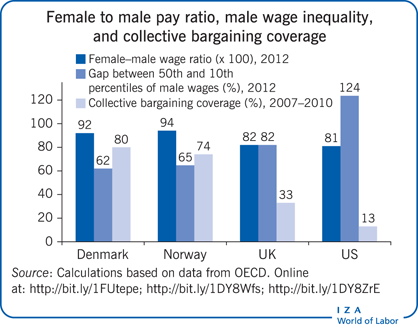Elevator pitch
There are large international differences in the gender pay gap. In some developed countries in 2010–2012, women were close to earnings parity with men, while in others large gaps remained. Since women and men have different average levels of education and experience and commonly work in different industries and occupations, multiple factors can influence the gender pay gap. Among them are skill supply and demand, unions, and minimum wages, which influence the economywide wage returns to education, experience, and occupational wage differentials. Systems of wage compression narrow the gender pay gap but may also lower demand for female workers.

Key findings
Pros
Wage-setting institutions that compress wages at the bottom of the distribution disproportionately raise the wages of low-paid workers, reducing inequality.
Wage compression raises women’s wages by more than men’s because women are more likely to be at the bottom of the distribution.
Wage floors can reduce exploitation of low-wage workers and enhance economic efficiency.
Cons
Reducing wage differentials based on skill may adversely affect an economy’s resource allocation by reducing workers’ incentives to acquire skills.
Low-wage workers, such as women, may experience employment losses as a result of wage floors.
Reducing occupational wage differentials may reduce women’s incentives to enter male-dominated occupations and thus contribute to the continuation of occupational segregation by gender.
If wage-setting institutions affect unemployment, they may also affect the sample used in measuring the gender wage gap.